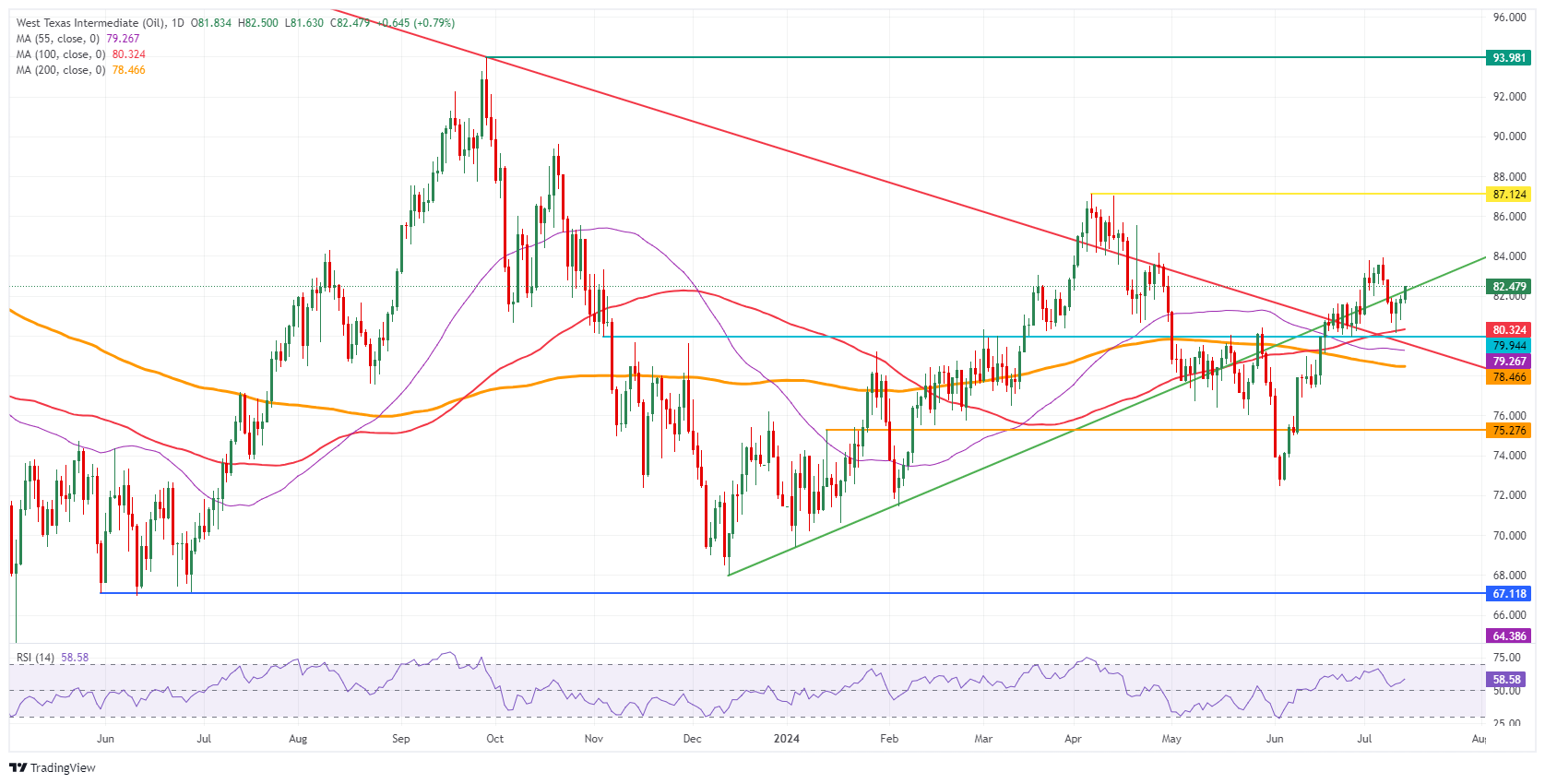- Oil prices rose for a third consecutive day on Friday.
- Traders see both bearish and bullish elements in the mix, which could lead to oil prices closing flat this week.
- The US Dollar Index is trading above 104.00 after its sharp drop on Thursday.
Oil prices are split, with several bearish and bullish elements in balance. Although oil started the week on the wrong foot, it is possibly on track to minimize the losses incurred this week and could even be flat overall by Friday’s close. The question will be how much overtaking will occur this summer ahead of the initial interest rate cut by the US Federal Reserve (Fed) expected in September and assumptions that demand will pick up in the wake of that.
Meanwhile, the US Dollar Index (DXY), which tracks the performance of the US Dollar against six major currencies, is building its way to recovery after the collapse it suffered on Thursday following the US Consumer Price Index (CPI) data for June, which showed a rise in disinflation. Markets were quick to lock in an interest rate cut for September, meaning the value of the US Dollar had to adjust as the rate differential with other currencies is narrowing. On Friday, traders will be watching to see whether the producer side of the economic system is also seeing a rise in disinflation with the release of the Producer Price Index (PPI) for June.
At the time of writing, WTI crude oil is trading at $82.05 and Brent Crude at $85.23
Oil news and market factors: IEA forecasts slow demand
- Bloomberg reports that China’s oil imports remained stable during June despite weak local demand. That was different for Liquefied Natural Gas (LNG), whose imports declined substantially in the same period.
- The Port of Houston is fully reopened, with ship traffic returning to normal on Thursday, Reuters reports. The port was closed after Hurricane Beryl passed through the region earlier in the week.
- Oil futures have seen a surge in demand since Thursday, with traders positioning for a rise in demand around September, when the Fed is expected to cut interest rates. Currently postponed construction projects should restart again, according to Reuters.
- The Wall Street Journal reports that the International Energy Agency has revised downward its recent forecast for 2025. Supply is expected to increase with the removal of OPEC production cuts, while demand is expected to fall from 1 million to 980,000 barrels per day. This would leave oil markets with an oversupply.
Oil technical analysis: No easy recovery
Oil prices are in the green for a third consecutive day, and if the recovery accelerates a bit on Friday, yields could close flat and avoid a weekly loss. For next week, if crude can manage a daily close above the green ascending trend line on the chart below, that would be a bullish signal for traders. Expect to see more investors enter crude futures once Fed officials confirm that the timing for September looks right for an initial interest rate cut.
On the upside, the July high near $84.00 is the first nearby resistance level to look for. Once that is surpassed, a new high for June and July will be printed as crude oil prices stretch higher. The Relative Strength Index (RSI) is already at 58 and will overheat fairly quickly, with $87.12, the 2024 high, still within reach.
On the downside, the large Simple Moving Average (SMA) belt should now act as support and no longer allow moves below it. That means the 100-day SMA at $80.32, the 55-day SMA at $79.26, and the 200-day SMA at $78.46 should prevent any drop below $78.00. If those levels don’t hold, another drop to $75 could occur.
WTI Crude Oil Daily Chart
WTI Oil FAQs
WTI crude oil is a type of crude oil sold on international markets. WTI stands for West Texas Intermediate, one of three main types that include Brent and Dubai crude. WTI is also known as “light” and “sweet” for its relatively low gravity and sulfur content, respectively. It is considered a high-quality oil that is easily refined. It is sourced in the United States and distributed through the Cushing hub, considered “the pipeline crossroads of the world.” It is a benchmark for the oil market and the price of WTI is frequently quoted in the media.
Like all assets, supply and demand are the main factors determining the price of WTI crude oil. As such, global growth can be a driver of increased demand and vice versa in the case of weak global growth. Political instability, wars and sanctions can disrupt supply and impact prices. Decisions by OPEC, a group of large oil producing countries, are another key driver of price. The value of the US Dollar influences the price of WTI crude oil, as oil is primarily traded in US Dollars, so a weaker Dollar can make oil more affordable and vice versa.
The weekly oil inventory reports published by the American Petroleum Institute (API) and the Energy Information Agency (EIA) influence the price of WTI oil. Changes in inventories reflect fluctuations in supply and demand. If the data show a decrease in inventories, it may indicate an increase in demand, which would push up the price of oil. An increase in inventories may reflect an increase in supply, which pushes down prices. The API report is published every Tuesday, and the EIA report the following day. Their results are usually similar, with a difference of 1% between them 75% of the time. The EIA data is considered more reliable because it is a government agency.
OPEC (Organization of the Petroleum Exporting Countries) is a group of 13 oil-producing nations that collectively decide on member countries’ production quotas at biennial meetings. Their decisions often influence WTI oil prices. When OPEC decides to reduce quotas, it can restrict supply and drive up oil prices. When OPEC increases production, the opposite effect occurs. OPEC+ is an expanded group that includes ten other non-OPEC countries, most notably Russia.
Source: Fx Street
I am Joshua Winder, a senior-level journalist and editor at World Stock Market. I specialize in covering news related to the stock market and economic trends. With more than 8 years of experience in this field, I have become an expert in financial reporting.








